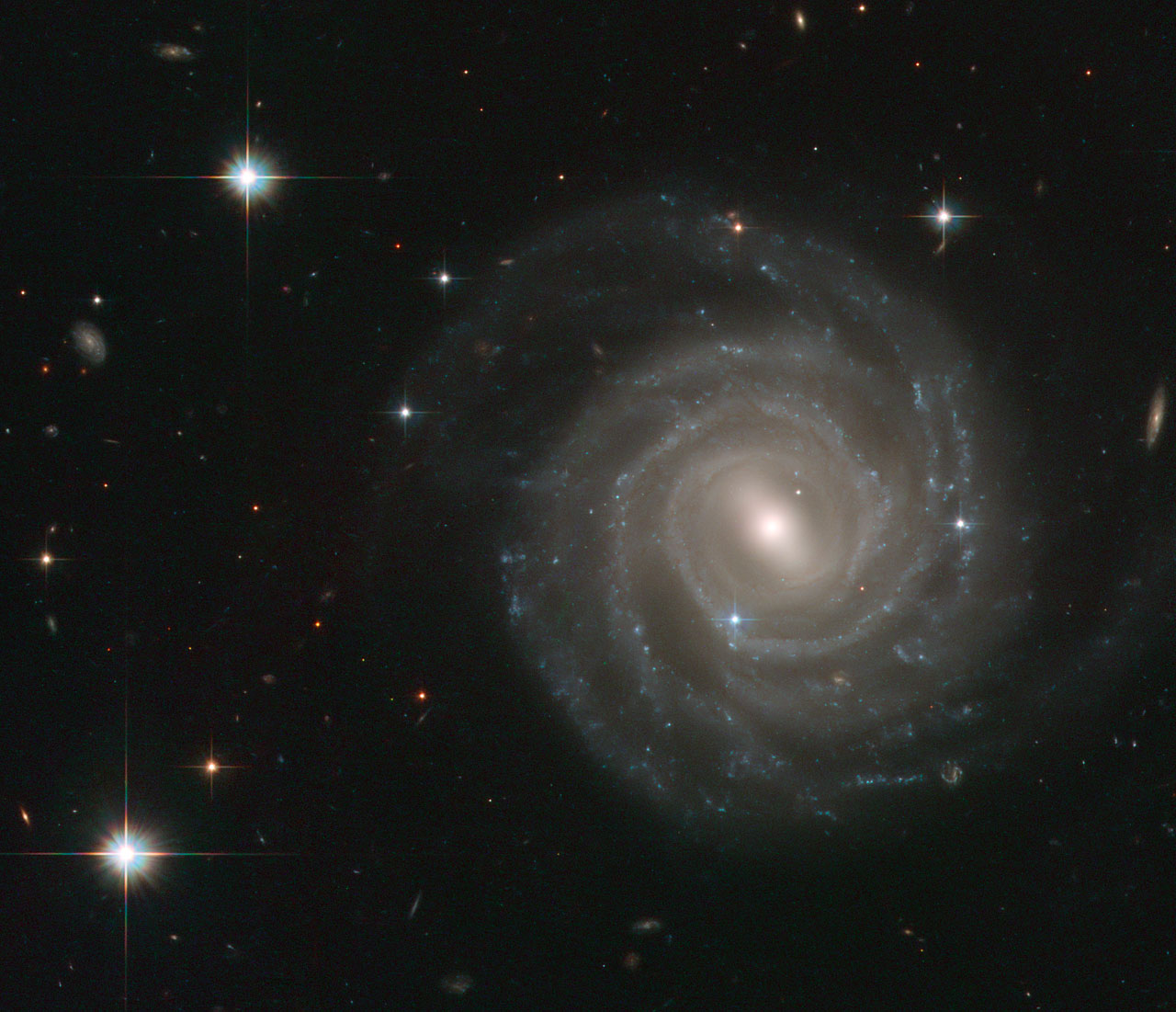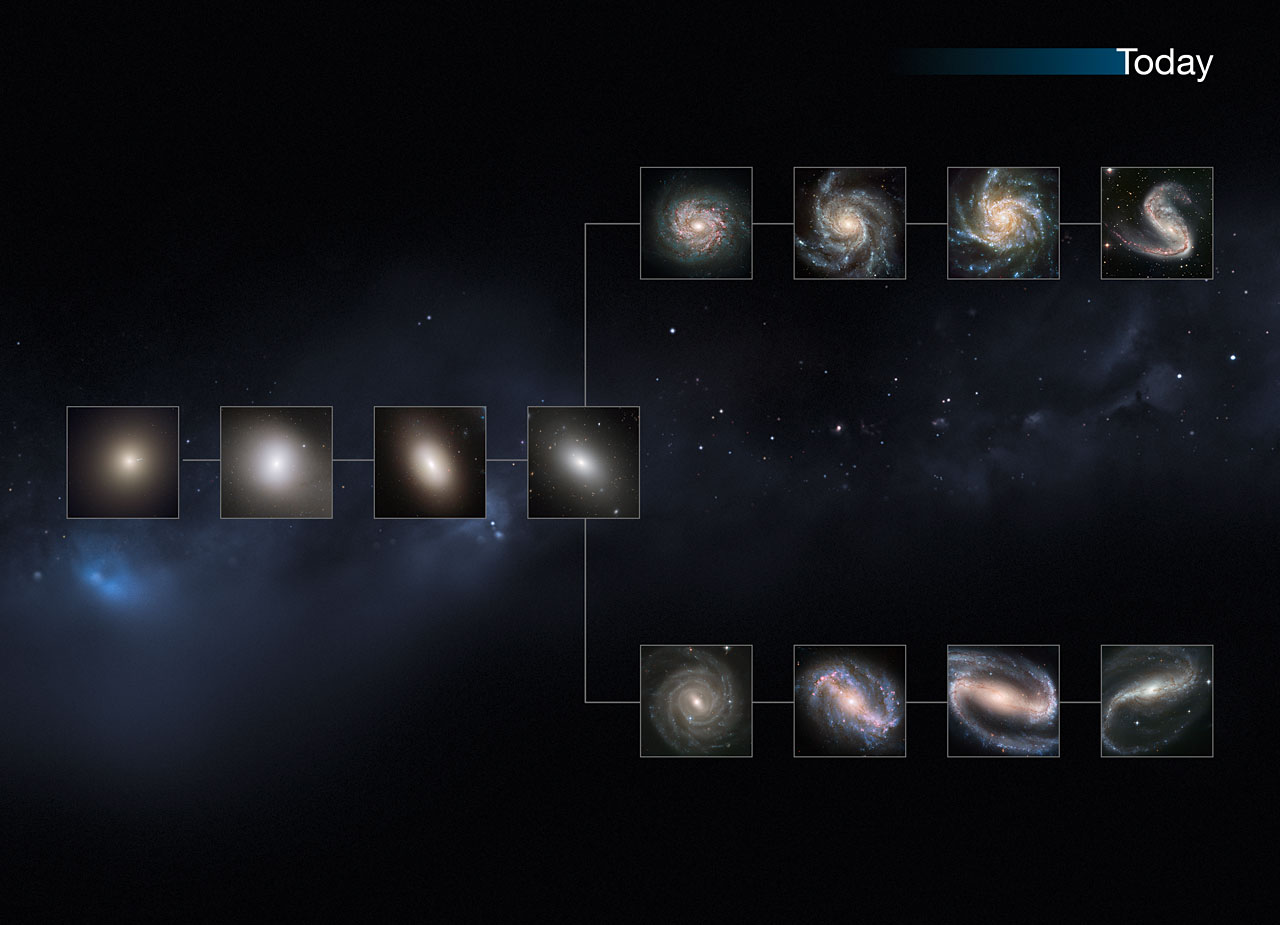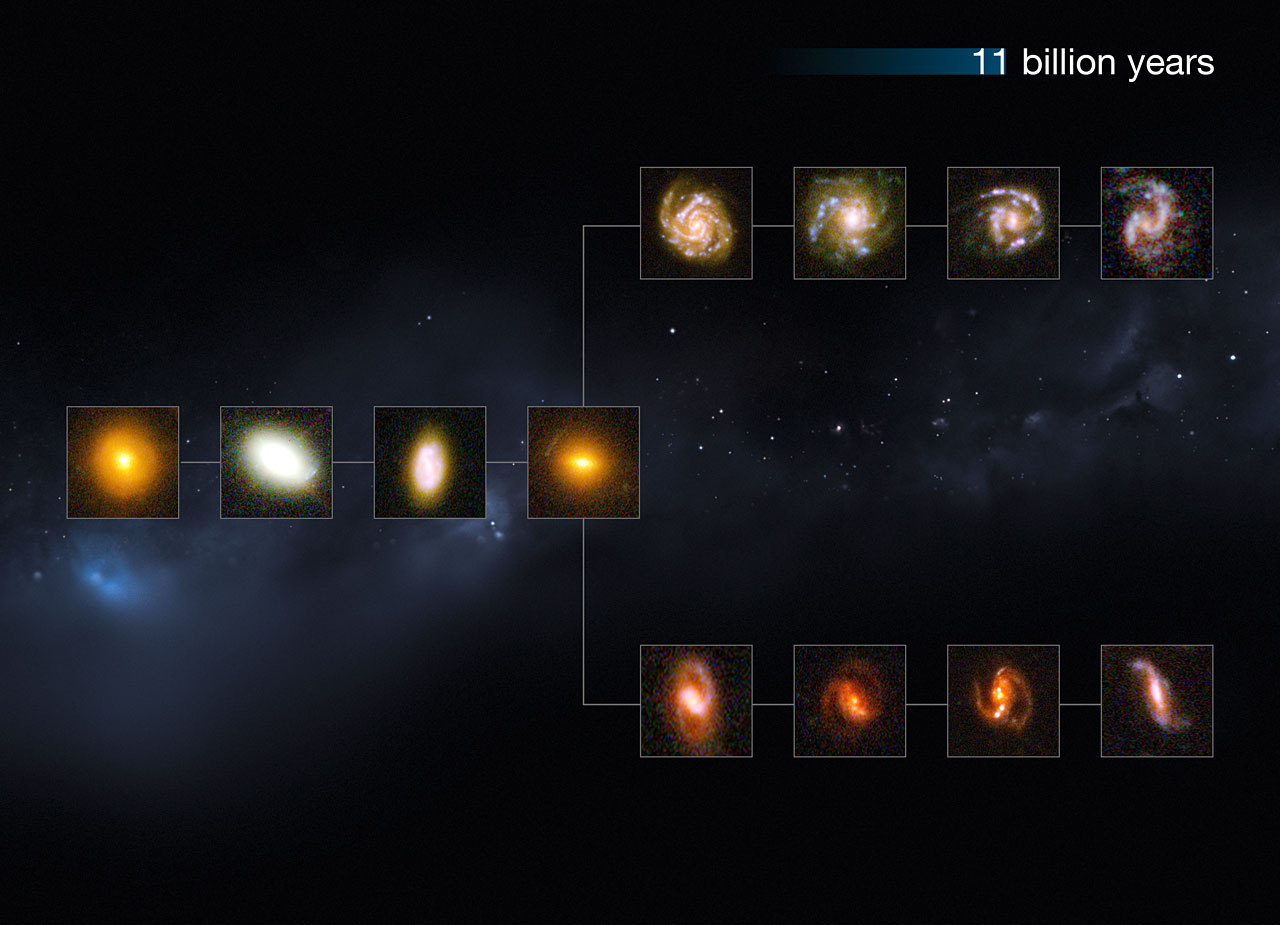The Hubble Space Telescope Cosmic Assembly Near-infrared Deep Extragalactic Legacy Survey (CANDELS), has found that galaxies eleven billion years ago were not that different from galaxies in the nearby universe. By observing the galaxies in infrared light, CANDELS has discovered the early galaxies' previously undetected populations of small cool stars whose light has been redshifted out of the optical part of the spectrum by the expansion of the universe.
Read more here.
Ann
Hubble sees true shape of galaxies 11 billion years ago
Hubble sees true shape of galaxies 11 billion years ago
Color Commentator
Magnificent spiral galaxy - like the Milky Way?
Image credit: NASA, ESA
What caught my eye, however, was this picture of typical nearby galaxies. Most of the spiral galaxies are easily recognizable - there is M 101, for example, which is number three in the upper row of spirals (the unbarred ones) and NGC 1300, number three in the row of barred spirals.
Credit: ESA/Hubble & NASA
What makes this galaxy so truly rare is its combination of multiple long thin arms and an extremely symmetrical, "circular" shape. When I tried to think of other galaxies that resemble it, I could only think of one - NGC 2857. NGC 2857 also has long thin arms and is extremely symmetrical. The main difference is that NGC 2857 is unbarred and has only two major arms, which means that it is a so-called "grand design" galaxy.
The fantastic multiple-armed barred galaxy is called UGC 12158, and you can read about it here.
How does a galaxy get shaped like UGC 12158? If I would hazard a guess, I would say that the galaxy is fairly large and massive, and that there is a lot of mass in its center, in its bar and nucleus. This central mass "pulls the arms in", preventing them from flaring out too much.
Also we can definitely see that this galaxy doesn't have a lot of star formation. The picture was taken through blue, orange, infrared and Ha filters, but not a single Ha region can be spotted in this galaxy. On the other hand, the arms are dotted with small blue clusters. This galaxy has suffered no major upheavals, no recent major mergers. The galaxy is just puttering about, slowly, whimsically hatching out a star here and a star there, along its long thin arms.
On the other hand, something must have happened to it to get it going at all. Little signs of disturbances can be spotted. At lower left, at about five o'clock, there is a small S-shaped object that is probably a background galaxy - but on the other hand, it can be resolved into blue clusters the same size and color as the blue clusters in the arms of UGC 12158. It is tempting to speculate that this might just be a really miniature dwarf galaxy colliding or otherwise interacting with the large spiral. Note the long straight line of blue clusters to the left of the S-shaped object, as if UGC 12158 had got a local burst of star formation going here in response to a local disturbance.
And in this serene-looking galaxy, a local outburst is going on. The blue star to the lower left of the bar of UGC 12159 is a supernova.
Size comparison of our Milky Way spiral galaxy with M74.
The Milky Way measures about 100,000 light years across; M74 about 30,000.
Credit: NASA (left) and Jim Misti
The Milky Way measures about 100,000 light years across; M74 about 30,000.
Credit: NASA (left) and Jim Misti
Is this true? Is our galaxy like UGC 12158? Admittedly there seems to be some similarities. The Milky Way is barred and does seem to have multiple arms, although it probably has only two major arms. But are our galaxy's arms long, thin and regular? I don't know if we know these things.
Maybe UGC 12158 is just the perfect, ideal galaxy, whose general shape artists will use as a blueprint when they imagine the shape of our own galactic home.
And they probably don't even know that they are really portraying UGC 12158.
Ann
Color Commentator
Hubble Sees True Shapes of Galaxies 11 Billion Years Ago
Hubble Sees True Shapes of Galaxies 11 Billion Years Back in Time
NASA | ESA | STScI | HubbleSite | 2013 Aug 15
Hubble explores the origins of modern galaxies
ESA/HEIC Hubble Science Release | 2013 Aug 15
CANDELS: The correlation between galaxy morphology and star formation activity at z~2 - Bomee Lee et al
Astronomers show galaxies had 'mature' shapes 11.5 billion years ago
University of Massachusetts, Amherst | 2013 Aug 15
NASA | ESA | STScI | HubbleSite | 2013 Aug 15
Looking 11 billion years back in time to when the universe was very young, astronomers have found that the anatomy of distant galaxies is not that different from galaxies seen in the nearby universe today. The results come from the Hubble Space Telescope Cosmic Assembly Near-infrared Deep Extragalactic Legacy Survey (CANDELS). The largest project in the history of Hubble, it aims to explore galactic evolution in the early universe, and the very first seeds of cosmic structure at less than 1 billion years after the Big Bang.
Previous studies of this early epoch were inconclusive because they were limited to visible light. Because of the stretching of light by the expansion of the universe the visible light detected in distant galaxies actually maps only the ultraviolet emissions of the galaxies. Because this radiation only comes from regions of active star formation the galaxies appeared to be clumpy and messy, with no resemblance to the galaxy shapes we see around us today. By observing the galaxies in infrared light with Hubble's Wide Field Camera 3, astronomers could observe how these distant galaxies would appear normally in visible light if their radiation were not stretched to infrared wavelengths by the expanding universe.
This image shows "slices" of the universe at different times throughout its history (present day, and at 4 billion and 11 billion years ago). Each slice goes further back in time, showing how galaxies of each type appear. The shape is that of the Hubble tuning-fork diagram, which describes and separates galaxies according to their morphology into spiral (S), elliptical (E), and lenticular (S0) galaxies. On the left of this diagram are the ellipticals, with lenticulars in the middle, and the spirals branching out on the right side. The spirals on the bottom branch have bars cutting through their centers.
The present-day universe shows big, fully formed, and intricate galaxy shapes. As we go further back in time, they become smaller and less mature, as these galaxies are still in the process of forming.
This image is illustrative. The Hubble images of nearby and distant galaxies used were selected based on their appearance; their individual distances are only approximate.
Credit: NASA, ESA, M. Kornmesser
Hubble explores the origins of modern galaxies
ESA/HEIC Hubble Science Release | 2013 Aug 15
Astronomers see true shapes of galaxies 11 billion years back in time
Astronomers have used observations from Hubble’s CANDELS survey to explore the sizes, shapes, and colours of distant galaxies over the last 80% of the Universe’s history. In the Universe today galaxies come in a variety of different forms, and are classified via a system known as the Hubble Sequence — and it turns out that this sequence was already in place as early as 11 billion years ago.
Image Credits: NASA, ESA, M. Kornmesser
The Hubble Sequence classifies galaxies according to their morphology and star-forming activity, organising them into a cosmic zoo of spiral, elliptical, and irregular shapes with whirling arms, fuzzy haloes and bright central bulges. Two main types of galaxy are identified in this sequence: elliptical and spiral, with a third type, lenticular, settling somewhere between the two.
This accurately describes what we see in the region of space around us, but how does galaxy morphology change as we look further back in time, to when the Universe was very young?
"This is a key question: when and over what timescale did the Hubble Sequence form?" says BoMee Lee of the University of Massachusetts, USA, lead author of a new paper exploring the sequence. "To do this you need to peer at distant galaxies and compare them to their closer relatives, to see if they too can be described in the same way."
The astronomers used Hubble to look 11 billion years back in time to when the Universe was very young, exploring the anatomy of distant galaxies.
While it was known that the Hubble Sequence holds true as far back as around 8 billion years ago [1], these new observations push a further 2.5 billion years back in cosmic time, covering a huge 80% of the past history of the Universe. Previous studies had also reached into this epoch of the cosmos to study lower-mass galaxies, but none had conclusively also looked at large, mature galaxies like the Milky Way. The new CANDELS observations confirm that all galaxies this far back — big and small alike — fit into the different classifications of the sequence.
"This is the only comprehensive study to date of the visual appearance of the large, massive galaxies that existed so far back in time," says co-author Arjen van der Wel of the Max Planck Institute for Astronomy in Heidelberg, Germany. "The galaxies look remarkably mature, which is not predicted by galaxy formation models to be the case that early on in the history of the Universe."
The galaxies at these earlier times appear to be split between blue star-forming galaxies with a complex structure — including discs, bulges, and messy clumps — and massive red galaxies that are no longer forming stars, as seen in the nearby Universe [2].
Galaxies as massive as the Milky Way or more are rather rare in the young Universe. This scarcity has prevented previous studies from being able to gather a large enough sample of mature galaxies to properly describe their characteristics.
What was needed was a systematic set of observations such as those from Hubble's CANDELS survey, which was large enough to allow the astronomers to analyse a larger number of these galaxies consistently, and in detail [3]. With Hubble's Wide Field Camera 3 (WFC3), the astronomers were able to observe in the infrared part of the spectrum to see how the galaxies appeared in their visible rest-frame [4], which is easier to compare with galaxies in our neighbourhood.
"The huge CANDELS dataset was a great resource for us to use in order to consistently study ancient galaxies in the early Universe," concludes Lee. "And the resolution and sensitivity of Hubble's WFC3 is second to none in the infrared wavelengths needed to carry out this study. The Hubble Sequence underpins a lot of what we know about how galaxies form and evolve — finding it to be in place this far back is a significant discovery."
- Notes:
[*] Previous studies have looked at the proportions of the different galaxy types back in time (heic1002). The mix of spiral, elliptical, lenticular and peculiar galaxies is different from today, with a great many more peculiars in the distant Universe than we see nearby.
[*] In a related recent paper, Alice Mortlock and collaborators took a different but complementary approach by classifying these distant galaxies by visual inspection. They found that the types of galaxies we see in the Hubble Sequence are well defined in terms of colour, structure, and star formation rates at very large distances from us, but that their morphology is still developing. While the morphology of a galaxy may be the final property to settle, the fundamentals of the Hubble Sequence are set much earlier on.
[*] CANDELS, the Cosmic Assembly Near-infrared Deep Extragalactic Legacy Survey, is the largest project in the history of Hubble, with 902 assigned orbits of observing time. It is being carried out with two cameras on board Hubble – WFC3 and ACS – and aims to explore galactic evolution in the early Universe, and the very first seeds of cosmic structure at less than one billion years after the Big Bang.
[*] Previous studies of this period of cosmic history were inconclusive as they were limited to visible light, showing only the redshifted ultraviolet emission of the galaxies, which highlights star formation. As this star formation dominated the observations, the galaxies appeared to be clumpy and messy, with no resemblance to the galaxy shapes we see around us today. By pushing into the infrared part of the spectrum the astronomers could observe how these distant galaxies appear in their visible rest frame (which is now redshifted).
CANDELS: The correlation between galaxy morphology and star formation activity at z~2 - Bomee Lee et al
- Astrophysical Journal 774(1) 47 (2013 Sep 01) DOI: 10.1088/0004-637X/774/1/47
arXiv.org > astro-ph > arXiv:1306.4980 > 20 Jun 2013 (v1), 02 Jul 2013 (v2)
Astronomers show galaxies had 'mature' shapes 11.5 billion years ago
University of Massachusetts, Amherst | 2013 Aug 15
Know the quiet place within your heart and touch the rainbow of possibility; be
alive to the gentle breeze of communication, and please stop being such a jerk. — Garrison Keillor
alive to the gentle breeze of communication, and please stop being such a jerk. — Garrison Keillor
- geckzilla
- Ocular Digitator
- Posts: 9180
- Joined: Wed Sep 12, 2007 12:42 pm
- Location: Modesto, CA
- Contact:
Re: Hubble sees true shape of galaxies 11 billion years ago
"Huge" is a bit of an understatement for the CANDELS data set. I'd go with "gi-fricking-normous"
Just call me "geck" because "zilla" is like a last name.
Re: Hubble sees true shape of galaxies 11 billion years ago
What a wonderful scientific term  I like it.
I like it. 
To find the Truth, you must go Beyond.





